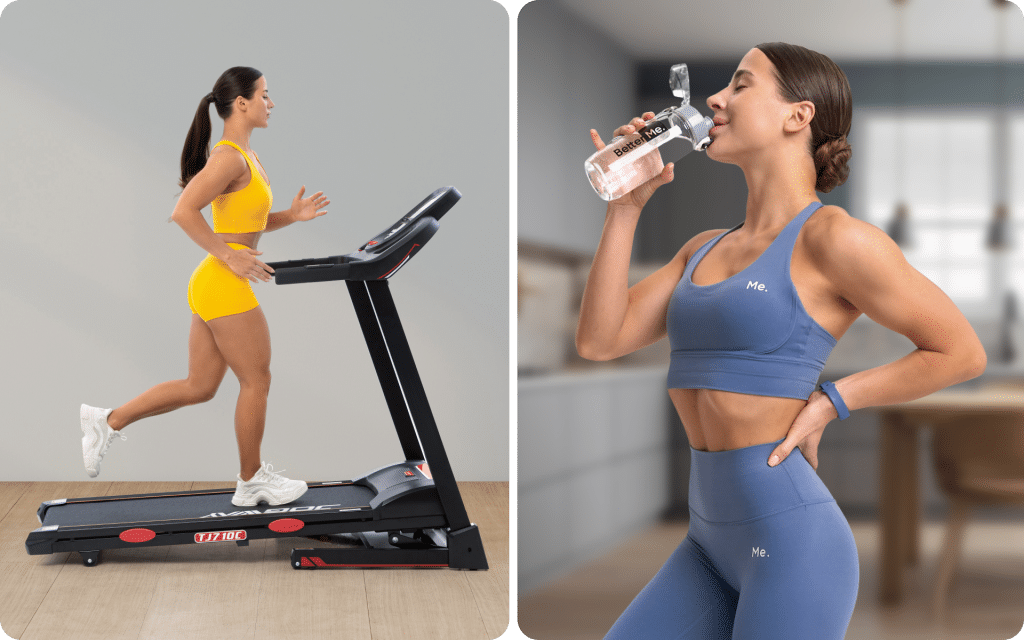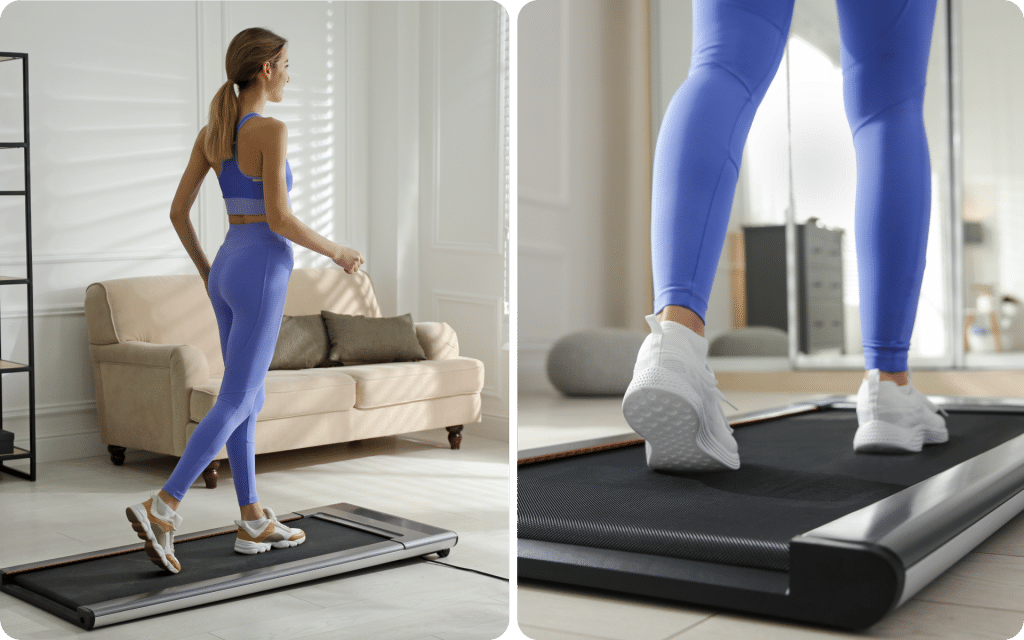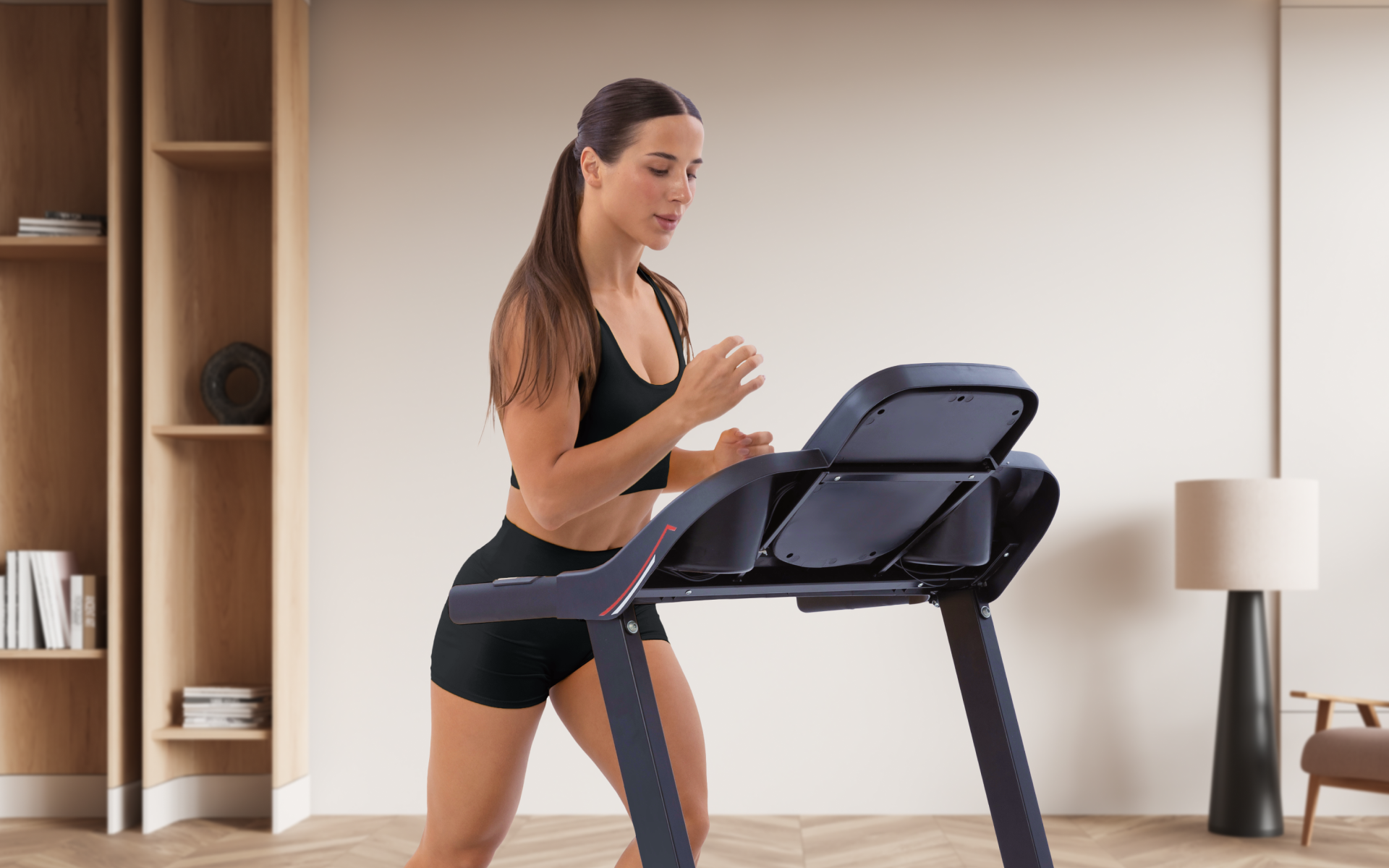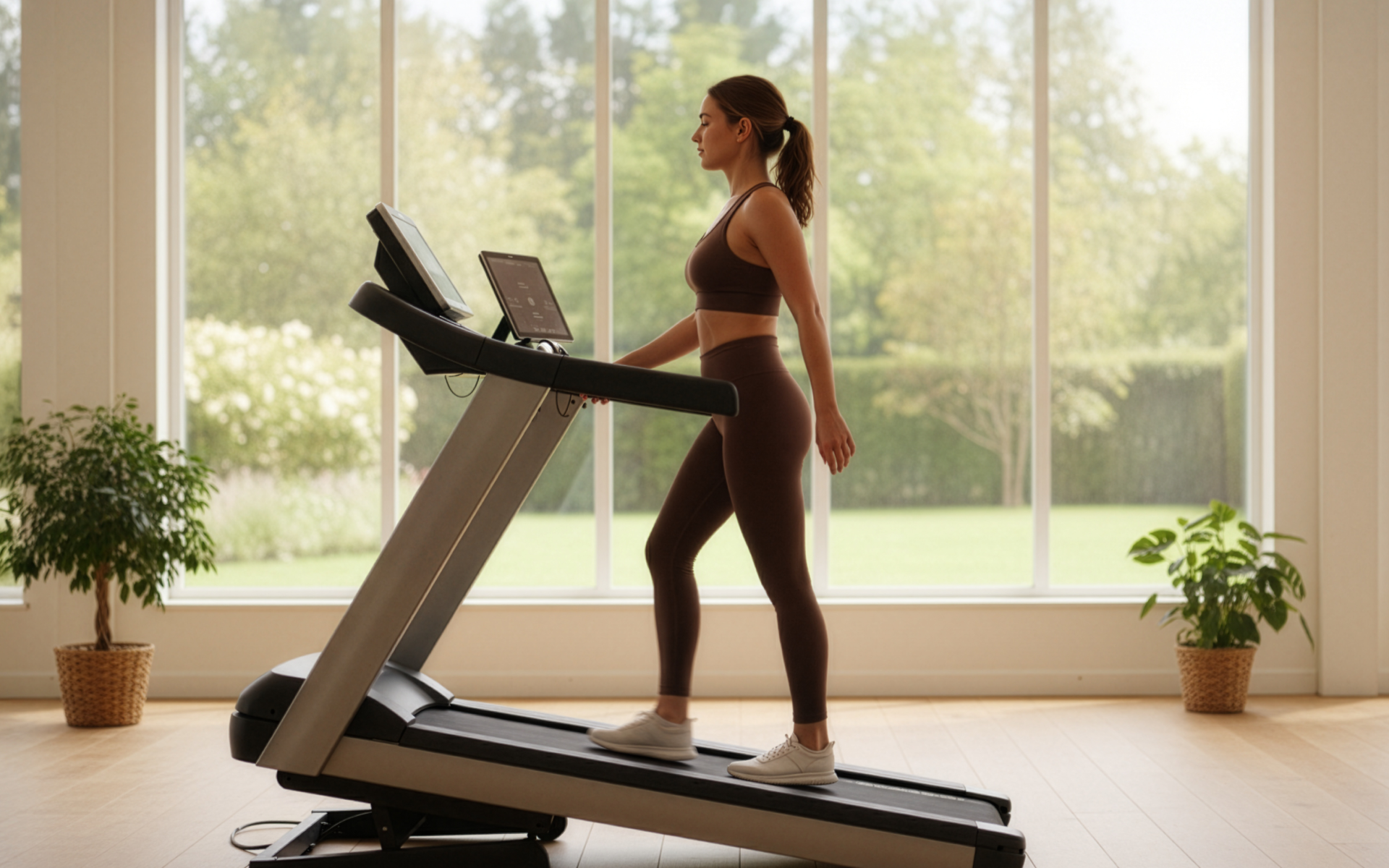So many people think of a treadmill as basic exercise equipment that’s only for beginners. We agree that walking is one of the most basic exercises (yet quite effective), but treadmills offer so much more! The benefits of an incline treadmill are manifold and include placing greater demand on your muscles, increasing your heart rate, and boosting your calorie burn. This article dives deep into the science behind treadmill hill workouts and how they could be the best thing you’ve ever done for your overall physical health. Check out these treadmill hill workouts if you’re an athlete or you want to make your workouts more intense.
What Is a Treadmill Hill Workout?
A treadmill hill workout is a running session that is performed on a treadmill with incline capabilities. Rather than simply running on a flat level, a hill workout includes running on a variety of inclines and speeds to replicate running on hills. This challenges the trainee’s muscles and cardiovascular system in new ways while adding variety to the training routine.
The following three treadmill hill workouts are great for building your stamina and leg strength, preparing for race day, or simply improving fitness. Before you start, keep the treadmill at a slight incline of 0.5% (except during warm-up and cool-down) to make your run feel more like running outdoors.
Intro to Hills Workout (40 minutes)
This beginner-friendly workout introduces your body to the challenge of incline running, which helps you build strength and endurance without overdoing it.
- Warm up by walking for 3 minutes.
- Run easy for 7 minutes.
- Repeat 4 times: Run for 2 minutes at a 3% incline at a moderate effort (Orange Zone, or Zone 3, 70-80% HRmax). Recover with 2 minutes of easy jogging or walking at 0% incline.
- Run easy for 5 minutes.
- Cool down by walking for 3 minutes.
Note: Focus on maintaining good form as the incline increases. A slight forward lean of the torso is acceptable as your body wants to maintain the center of balance. However, it shouldn’t be excessive and you still need to keep your chest up and engage your core. You’ll likely need to shorten your stride slightly to stay efficient.
Strength Builder Hill Workout (45 minutes)
This workout targets muscular endurance and glute activation by increasing incline and intensity across multiple rounds.
- Warm up by walking for 2 minutes.
- Run easy for 5 minutes.
- Repeat 6 times: Run for 90 seconds at a 5 to 6% incline at a steady hard effort (low Red Zone, 80-85% HRmax). Recover with a 90-second walk or very easy jog at 0% incline.
- Run easy for 6 minutes.
- Cool down by walking for 2 minutes.
Note: Push uphill, but make sure your breathing is controlled enough to avoid early burnout. Think of this as a strength session, not a speed workout.
BetterMe: Health Coaching app helps you achieve your body goals with ease and efficiency by helping to choose proper meal plans and effective workouts. Start using our app and you will see good results in a short time.
Rolling Hills Endurance Workout (50-55 minutes)
This treadmill workout is designed to mimic an undulating course and helps train your legs to handle frequent incline changes without a dip in performance.
- Warm up by walking for 2 minutes.
- Run easy for 6 minutes.
- Repeat 5 times: Alternate between 2 minutes at 2%incline, 2 minutes at 4% incline, and 2 minutes at 0% incline, all at a consistent effort level (Orange Zone, 70-80% HRmax).
- Run easy for 6 minutes.
- Cool down by walking for 2-3 minutes.
Note: Don’t worry about keeping the same pace as the incline increases. Instead, focus on maintaining a steady effort. This may mean slowing down as the incline gets steeper, and that’s okay. Over time, this approach will help build stamina and prepare you for varied terrain outdoors.
Read more: Beginner Treadmill Glute Workout for Maximum Activation and Definition
Are Treadmill Hill Workouts Effective?
Yes, absolutely. Treadmill hill workout walking can be one of the best favors you do to yourself. By adding more incline and resistance, you make your muscles work extra hard, particularly your hamstrings and glutes. When you increase the intensity, you can improve your heart rate and cause greater calorie burn than a typical flat treadmill walk.
Keep in mind that you can tailor each session to your specific needs. For example, you can change the percentage of the treadmill’s incline or speed of running to challenge your body in various ways. This increases muscle endurance, stamina, and muscular strength without stepping off the machine. Therefore, a 30-minute treadmill hill workout before or after your day can uplift your mood and bring you many physical benefits.
Is Walking Uphill on a Treadmill Good Exercise?
Mixing things up, such as by adding different fun treadmill hill workouts, keeps boredom at bay and gives your body the challenge it craves to level up.
Check out these awesome benefits of hill running that make this training a must-add to your fitness game!
- Boosts Heart Rate
Doing cardio exercises such as walking, running, or jogging increases your heart rate. However, when you make it more challenging by walking uphill, it can boost your heart rate even more. This leads to better blood circulation and muscle oxygenation.
Studies have revealed that a hill workout on a treadmill incline increases heart rate with each bump in the incline. In the study, 18 male runners ran for 5 minutes on a 0% incline. Their heart rate was recorded at 148 bpm. When the incline was raised to 7%, their heart rate increased to around 170 bpm at the same speed (±11.37 bpm), which shows how an incline adds intensity to the workout (1).
- Increases Calorie Burn
When you work out, you burn calories. The number of calories depends on factors such as your fitness level, age, lifestyle, and genetics. At the same time, it also depends on the intensity of your exercise. Research revealed that running on an incline treadmill can increase the metabolic cost by 17% at a 5% incline and about 32% at a 10% incline (2).
For example, a 155-pound individual who walks at 3.5 mph on a flat surface for 1 hour can burn approximately 267 calories. The same person may lose up to 422 calories when walking uphill at the same speed (3). Therefore, all you need is a well-designed incline treadmill to optimize your weight loss for total fat loss.
- Challenges Your Leg Muscles
If you repeatedly do the same workout over and over again at the same intensity, your muscles will stop progressing as you’re not applying greater demand. This can stall your growth and improvement. In contrast, when you increase the workout intensity, it places a greater demand on your muscles, improving your endurance.
Compared to walking on a flat surface, working out on an incline treadmill can activate your lower leg muscles to a higher degree – this includes your tibialis anterior, peroneals, gastrocnemius, and soleus. (4).
- Busts Boredom
Doing the same exercises daily can be boring and stall progress. This keeps you from witnessing any progress over time, which can be discouraging. A hill workout on a treadmill incline can challenge your body and keep you motivated to achieve more. For example, you can adjust speed, the level of incline, or add hand weights to increase difficulty. You can also incorporate other exercises such as lunges into your workout, which will significantly increase muscle strength and fitness.
- Targets Posterior Muscles
Walking on a flat surface works your entire lower body. However, when training with a hill running workout, you’ll engage your glutes and hamstrings to a higher degree. These are the key muscles on the back of your legs. Strengthening these posterior muscles can boost your posture, help prevent injuries, and bring a notable boost in your physical performance (5).
How to Do a Hill Workout on a Treadmill
Hill workouts are the secret sauce to building strength, stamina, and serious cardio endurance. The best part is that it all happens without needing to step outside!
Here are some tips to keep in mind when doing one:
1. Start with a Warm-Up: Walk or jog at 0-0.5% incline for 3-5 minutes to wake up your muscles and get your blood flowing.
2. Set the Stage (Incline and Speed): Increase the incline to 3-6% and adjust your speed to a challenging but doable pace. You should be breathing hard, but still in control, like chasing a bus, not outrunning a bear.
3. Work in Intervals:
- Run or power walk uphill for 1-2 minutes.
- Recover with a 2-minute easy jog or walk at 0% incline.
- Repeat 4-8 times, depending on your fitness level.
4. Cool Down: Walk it out at a 0% incline for 3-5 minutes to decrease your heart rate.
Don’t sprint uphill as if you’re on fire – focus on form: shorter strides, upright posture, and controlled breathing.
What Is a Full Treadmill Hill Workout Plan?
The plan below can boost your cardio and fire up your metabolism, all in one go.
Warm-Up (5 minutes)
- Walk or jog at 0-0.5% incline
- Keep it light and easy. Just enough to break a sweat
Hill Intervals (25-30 minutes)
- Repeat the cycle below 6-8 times:
| Interval | Incline | Duration | Intensity |
|---|---|---|---|
| Hill Run/Walk | 4-6% | 90 seconds | Hard effort (can't hold a convo) |
| Recovery | 0% | 2 minutes | Easy jog or brisk walk |
- Reduce the incline to 3% if you’re new or walk instead of running.
Rolling Hills (10-15 minutes)
Alternate incline every 2 minutes:
- 2% → 4% → 6% → 4% → 2%
- Maintain a steady, moderate pace
Cool Down (5-10 minutes)
- Walk at 0% incline
- Focus on deep breathing and relaxing your muscles
Research in Sports Medicine showed that incline training improves VO2 max and muscle efficiency (6). It also lowers joint stress, which makes it a smart choice for both runners and walkers.
Read more: Treadmill Benefits: What It Does for Your Body
What Happens if I Walk Uphill Every Day?
Walking uphill every day packs a powerful punch of health benefits. The good news is that people of all ages and fitness levels can do the uphill workout.
Walking uphill, you’ll notice your heart beating more rapidly and pressure in your lower-leg muscles. Uphill walking can engage your posterior muscles, which causes a burn when you complete your workout.
Regular uphill workouts can strengthen your glutes, hamstrings, and calves, improving your flexibility, posture, mobility, and strength. The calories burned hiking also contribute to fat loss, which is one of the common reasons why people hop onto the treadmills in the first place.
Also, hill workouts provide amazing training for your calves, a muscle that is often neglected during leg workouts. Uphill walking engages these overlooked muscles, which can increase your lower-body strength and balance.
Whether you’re a workout beast or just a beginner making your first foray into the world of fitness and dieting – BetterMe has a lot to offer to both newbies and experts! Install the app and experience the versatility first-hand!
Another obvious benefit is an improved heart rate. A 2013 study revealed that running on a 2-7% incline increases the heart rate by 4% and 10% respectively compared to running on a flat surface (1).
It’s important to note that you may experience muscle soreness when you first start treadmill hill workouts. In this case, you must take a day off and allow your muscles to recover. Make sure to start your training program with less intense workouts that include slow to moderate speeds and smaller inclines. Over time, you can add them to your daily workout routine when your muscles get used to uphill walking.
Is Walking Uphill Better than Running?
Uphill walking and running are both excellent forms of cardiovascular exercise. Each comes with its unique and powerful perks. At the end of the day, the choice between the two will depend on your fitness goals and preferences.
To get a better idea of which exercise is better, we address the benefits of each in the table below:
| Aspect | Uphill Walking | Running |
|---|---|---|
| Cardiovascular Benefits | Rapidly increases heart rate and boosts cardiovascular fitness. | Strong cardio benefits due to the high intensity. |
| Joint Impact | Low-impact - gentler on the knees, hips, and ankles. | High-impact. It can strain joints and increase injury risk over time. |
| Accessibility | Beginner-friendly and easier to control the intensity. | Requires a higher fitness level - more physically demanding. |
| Calorie Burn | Moderate calorie burn. | Burns 500-700 calories/hour due to the intensity. |
| Muscle Engagement | Targets the glutes, hamstrings, and calves gradually. | Builds overall strength and improves bone density. |
| Injury Risk | Lower risk when done with proper form. | Risk of overuse injuries such as stress fractures and plantar fasciitis. |
| Best For | People who are easing into fitness, recovering, or protecting their joints. | Fit individuals who are looking for faster calorie burn and performance gains. |
Walking uphill on a treadmill can activate your glute muscles more than walking on a flat surface. The incline forces your hips and hamstrings to work harder with each step, and this can lead to stronger and more defined glutes over time. Yes, incline walking targets major leg muscles such as the quads, hamstrings, calves, and glutes. The added resistance can build muscle endurance and shape, which can make your legs look more toned and sculpted. Not necessarily. Walking on an incline can be gentler on your knees than running on a flat surface as it reduces impact. However, steep inclines or poor walking form can place extra stress on your joints. To avoid discomfort, start with a moderate incline and make sure your posture and stride are correct. Running uphill daily isn’t suitable for everyone. Without enough rest or variety, this may lead to overuse injuries. It’s better to mix uphill runs with recovery days or different types of workouts in order to keep your body balanced and injury-free.Frequently Asked Questions
Does walking uphill on a treadmill build glutes?
Does walking uphill on a treadmill tone your legs?
Is an incline treadmill bad for your knees?
Is it OK to run uphill every day?
The Bottom Line
Treadmill hill workouts are an excellent way to increase your fitness. They target diverse muscle groups, burn calories, and boost your cardiovascular health. As with every other exercise regimen, make sure to consult your doctor before you start, particularly if you have any underlying health conditions or haven’t exercised in a while. Remember to take it slow and only increase the intensity when your body feels ready to do so.
DISCLAIMER:
This article is intended for general informational purposes only and does not serve to address individual circumstances. It is not a substitute for professional advice or help and should not be relied on for making any kind of decision-making. Any action taken as a direct or indirect result of the information in this article is entirely at your own risk and is your sole responsibility.
BetterMe, its content staff, and its medical advisors accept no responsibility for inaccuracies, errors, misstatements, inconsistencies, or omissions and specifically disclaim any liability, loss or risk, personal, professional or otherwise, which may be incurred as a consequence, directly or indirectly, of the use and/or application of any content.
You should always seek the advice of your physician or other qualified health provider with any questions you may have regarding a medical condition or your specific situation. Never disregard professional medical advice or delay seeking it because of BetterMe content. If you suspect or think you may have a medical emergency, call your doctor.
SOURCES:
- A Paradigm of Uphill Running (2013, pmc.ncbi.nlm.nih.gov)
- Predicting the Metabolic Cost of Incline Walking from Muscle Activity and Walking Mechanics (2015, pmc.ncbi.nlm.nih.gov)
- Calories Burned Walking Uphill Calculator (n.d., caloriejam.com)
- Peroneal muscle activity during different types of walking (2018, pubmed.ncbi.nlm.nih.gov)
- Posterior Chain Exercises for Prevention and Treatment of Low Back Pain (2017, journals.lww.com)
- The Effects of Incline and Level-Grade High-Intensity Interval Treadmill Training on Running Economy and Muscle Power in Well-Trained Distance Runners (2013, researchgate.net)












